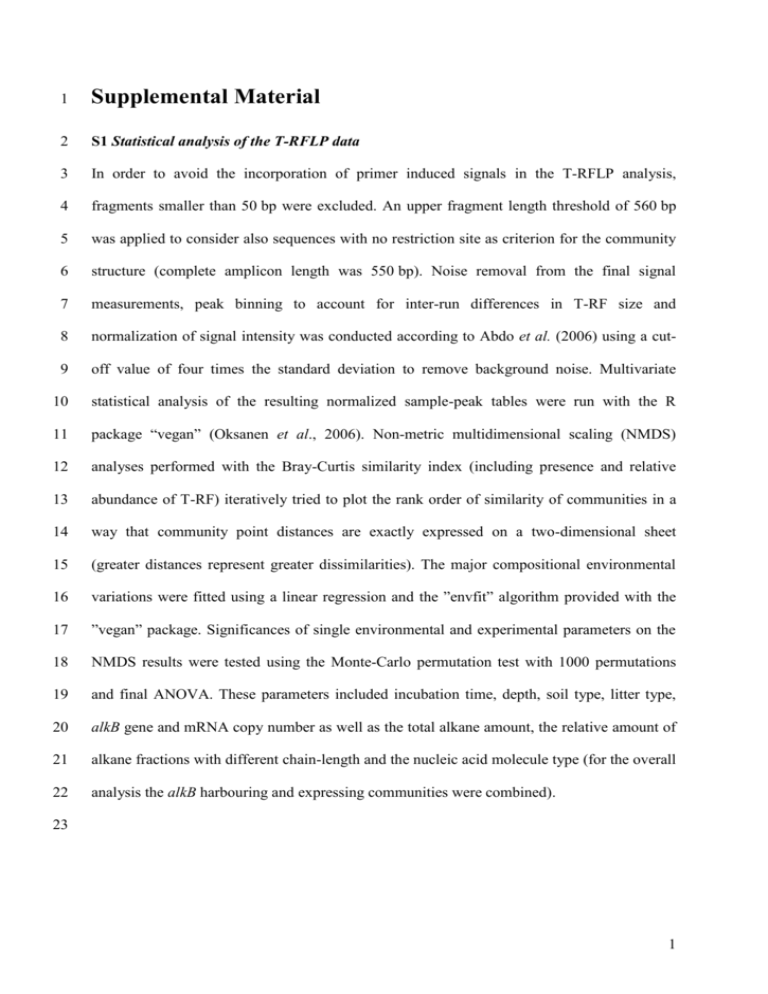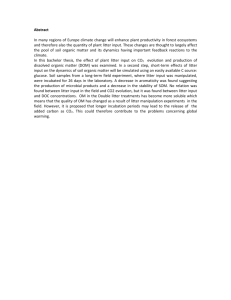Abundance, activity and diversity of alkane degrading
advertisement

1 Supplemental Material 2 S1 Statistical analysis of the T-RFLP data 3 In order to avoid the incorporation of primer induced signals in the T-RFLP analysis, 4 fragments smaller than 50 bp were excluded. An upper fragment length threshold of 560 bp 5 was applied to consider also sequences with no restriction site as criterion for the community 6 structure (complete amplicon length was 550 bp). Noise removal from the final signal 7 measurements, peak binning to account for inter-run differences in T-RF size and 8 normalization of signal intensity was conducted according to Abdo et al. (2006) using a cut- 9 off value of four times the standard deviation to remove background noise. Multivariate 10 statistical analysis of the resulting normalized sample-peak tables were run with the R 11 package “vegan” (Oksanen et al., 2006). Non-metric multidimensional scaling (NMDS) 12 analyses performed with the Bray-Curtis similarity index (including presence and relative 13 abundance of T-RF) iteratively tried to plot the rank order of similarity of communities in a 14 way that community point distances are exactly expressed on a two-dimensional sheet 15 (greater distances represent greater dissimilarities). The major compositional environmental 16 variations were fitted using a linear regression and the ”envfit” algorithm provided with the 17 ”vegan” package. Significances of single environmental and experimental parameters on the 18 NMDS results were tested using the Monte-Carlo permutation test with 1000 permutations 19 and final ANOVA. These parameters included incubation time, depth, soil type, litter type, 20 alkB gene and mRNA copy number as well as the total alkane amount, the relative amount of 21 alkane fractions with different chain-length and the nucleic acid molecule type (for the overall 22 analysis the alkB harbouring and expressing communities were combined). 23 1 24 S2 Significance levels of factors influencing the litter decay in microcosms covered with 25 maize or pea litter respectively. 26 27 S3 Relative abundances of terminal restriction fragments (T-RF) in DNA or mRNA samples 28 from litter, soil and control compartments detected also in soil and litter isolates. For the 29 calculation, all samples in one sampling group (litter; soil; control) were summed with no 30 differentiation of litter-, soil type, compartment and incubation time. 31 32 S4 Significance levels of environmental factors correlating with community structure 33 changes in alkB harbouring (DNA) or expressing (mRNA) communities (based on NMDS of 34 T-RFLP data) in the sandy and the silty soil microcosms incubated with maize or pea straw, 35 respectively. In addition, litter communities are also included (maize; pea). Significance 36 levels for the overall analysis including T-RFLP analysis of all treatments and layers on alkB 37 gene and expression level are given in the last column (all). P values are based on Monte- 38 Carlo permutation with 1000 permutations and final ANOVA. 39 40 S5 Relative amount of remaining litter of maize and pea plants after incubation of sandy and 41 silty soil microcosms, referred to an initial amount of 1g (dw) of fresh litter material. Error 42 bars denote standard deviation (n = 3). 43 44 S6 Community structure cluster analyses of alkB genes (A, B) and transcripts (C, D) in silty 45 and sandy soil microcosms covered either with maize (A, C) or pea (B, D) litter as well as in 46 the non-litter controls. 47 48 S7 Number of T-RF (i.e. richness) detected in two soil compartments (litter-soil interface, 49 bulk soil) after the incubation with maize and pea litter with differentiation of T-RF 2 50 exclusively detected in sand, silt and shared T-RF between both soil types. For reasons of 51 simplification no differentiation between the two soil compartments was included. 52 53 S8 T-RF in soil microcosms incubated with maize and pea litter with differentiation of T-RF 54 exclusively detected in litter, soil and shared T-RF between litter and soil samples. For 55 reasons of simplification no differentiation between the two soil compartments was included. 56 57 S9 T-RFLP based NMDS blot of all alkB gene harbouring and expressing communities of the 58 microcosm experiments. Community similarity was calculated using Bray-Curtis similarity 59 measurement. Arrows are correlation vectors of community structure differences and 60 environmental conditions with significance factors P < 0.1 (for exact significance level see 61 S4). Monte-Carlo permutation model based analysis with 1000 permutation and final 62 ANOVA was applied to test for significance. 63 64 3



